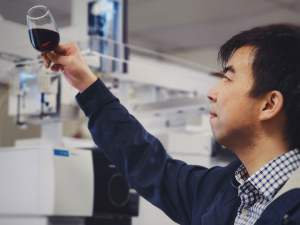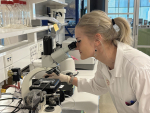In May this year, PhD student Wenyao (Arthur) Zhu, published a paper in the Journal of Agricultural and Food Chemistry, alongside research partners Frank Benkwitz of Kim Crawford Winery and Professor Paul Kilmartin, from The University of Auckland Wine Science Programme.
In this Q&A, Wenyao gives some insights into the paper, Alternative Perspective on Rapid Wine Oxidation through Changes in Gas-Phase Volatile Concentrations, Highlighted by Matrix Component Effects.
How did you become involved in the Wine Sciences Programme at the University of Auckland?
My background in food science when I did my Bachelor and Master studies in Australia deeply interested me in sensory science topics. The many unsolved mysteries in its aroma make wine a perfect research subject in sensory studies. I was utterly fortunate to be able to carry out wine research in New Zealand at the University of Auckland, an institution where I don’t just do research but also get to relate my insights with real-world wine productions.
How is oxidation traditionally assessed?
Wine oxidation is traditionally viewed from a flavour perspective, which has a lot to do with looking at how phenolics evolve. People also study oxidation from an odour perspective by looking at the drop of fruity aroma compounds, or the development/ accentuation of notorious volatiles such as acetaldehyde and ethyl acetate. When it comes to relating oxidation to volatiles though, the default way was to focus on the absolute concentrations of those compounds, as that is what the instruments used for such tasks can detect.
How is your research different?
My study focused on using our instrument, gas chromatography-ion mobility spectrometry (GC-IMS), to directly mimic the human sensory experience, instead of just looking at the concentrations of some important fruity esters in wine. The concept of partial pressure is rather sparingly used in sensory research in general, let alone wine-related studies. The partial pressure links the absolute amount of a volatile compound to its tendency to get released from the bulk of wine into headspace. Thus, by comparing different partial pressures, we can have a better understanding of how important each of the aroma compounds really is in shaping our overall perception of a wine aroma-wise.
What did you find?
Some important volatile compounds in wine that impart fruity and flowery aroma like ethyl octanoate, ethyl hexanoate, and isoamyl acetate drop much more greatly in partial pressure during oxidation, compared to their concentrations. This shows more accurately how badly oxidised wines can lose their fruitiness. Also, common winemaking additions like copper and ascorbic acid may have varied impacts on wine’s anti-oxidation capacity. A highlight of our finding is that, for full-alcohol (12%) wine, adding 50 ppm ascorbic acid makes it more likely to lose fruitiness after 30-day oxidation, while for low-alcohol (7%) wine, the same ascorbic acid addition helps to preserve fruity aroma after 30-day oxidation.
Why is wine a good field of research?
Wine is a complicated system in which many factors interact to affect what consumers eventually perceive. It is the interactions that make wine a fascinating object to study. Wine research offers the tool to re-evaluate traditional winemaking methods, and to inspire novel approaches. Many traditional practices are empirical and lack scientific premises to justify what should or shouldn’t be done. Wine research thus is both interesting and important to protect the economic significance of New Zealand’s wine industry.
Where will it take you next?
This work is a fine demonstration of what the GC-IMS is capable of. Still, there are aspects that can be improved. It might also be interesting to look at compounds other than esters that are similarly important for wines, such as terpenes and volatile sulfur compounds once we get suitable GC columns installed. This would enable us to investigate not just wine oxidation but also reductive odours in wines, which is yet another common problem bothering New Zealand winemakers.
What support have you had for this work?
My PhD research is funded by the Callaghan Innovation Research and Development Fellowship Grant. I received immense help from my supervisors Professor Paul Kilmartin and Dr Frank Benkwitz. Paul always enlightens me with his plentiful knowledge in wine. Frank is more like half-supervisor and half-mentor, who never stops to encourage me to “think outside the box” and experiment with new methodologies. I’m truly indebted to both of them.
Find the full paper at doi.org/10.1021/acs.jafc.2c00437














